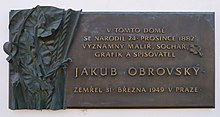Jakub Obrovský

| Medal record | ||
|---|---|---|
| Art competitions | ||
| Representing | ||
| Olympic Games | ||
| 1932 Los Angeles | Sculpture: Statues | |
Jakub Obrovský (December 24, 1882 – March 31, 1949) was a Czechoslovak artist, sculptor and writer.
Biography


Jakub Obrovský was born in Brno-Bystrc. He studied at the School of Applied Arts in Prague with Celda Klouček, EK Liška and Stanislav Sucharda (1897-1901) and continued his studies at the Academy of Fine Arts with Max Pirner (1901-1905). In 1919 he became a professor at the Academy of Fine Arts, and later served as the rector.
Obrovský favored women's figures in his paintings, and often sculpted figures of athletes. He designed early stamps of the new Republic of Czechoslovakia: the lion escaping from its chains (28 October 1919) and the allegory of economy (1920).[1]
In 1932 he won a bronze medal for Czechoslovakia in the art competitions of the Olympic Games for his "Odysseus" (see Art competitions at the 1932 Summer Olympics).[2]
Obrovský died in Prague. His daughter Jana Obrovská (1930 – 1987) became a noted Czech composer.
References
- ^ Michel Katalog Ost 1985–86
- ^ "Jakub Obrovský". Olympedia. Retrieved 24 July 2020.
- The Games of the Xth Olympiad Los Angeles 1932 (PDF). Xth Olympiade Committee of the Games of Los Angeles, U.S.A. 1932. 1933. pp. 748–765. Archived from the original (PDF) on 2008-04-10.
- Wagner, Juergen. "Olympic Art Competition 1932". Olympic Games Museum. Archived from the original on 2008-05-01.
- Kramer, Bernhard (May 2004). "In Search of the Lost Champions of the Olympic Art Contests" (PDF). Journal of Olympic History. 12 (2): 29–34. Archived (PDF) from the original on 2008-04-10.
- Evans, Hilary; Gjerde, Arild; Heijmans, Jeroen; Mallon, Bill; et al. "Jakub Obrovský". Olympics at Sports-Reference.com. Sports Reference LLC. Archived from the original on 2016-03-14. Retrieved 2016-05-29.
External links
- profile (in German)
- Virtual show
